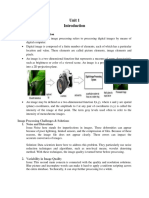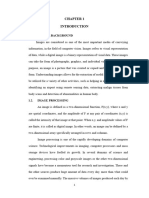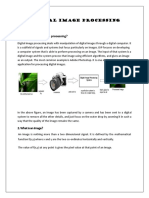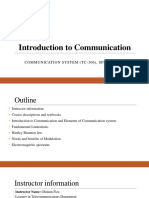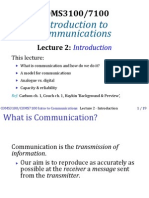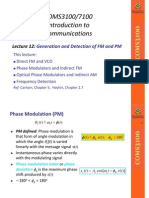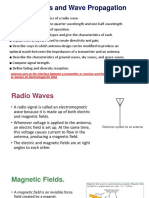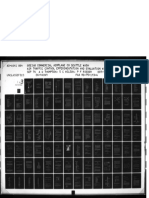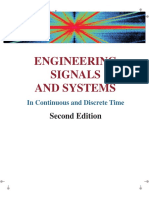Digital
Image Processing
Presented by
A.Kanchana,
Email:akula_kanchana@yahoo.com
&
Chavva himabindu
Email:chavvahimabindu4@gmail.com
III Btech EEE,
Intell engineering college,
Anantapur.
�Introdution
Digital
Image processing is electronic
data processing on a 2-D array of
numbers. The array is a numeric
representation of an image.An image
processing system consists of a source
of image data, a processing element
and a destination for the processed
results.
In
the age multimedia life.No other
medium can offer the expressive
images have become an integrated
part of human power of the image or a
video sequence.Because images
contain an enormous amount of
information .clearly,images contain
and convey information in the form,
which human beings can easily
�What are Images?
Images are signals with special characteristics.
They are measure of a parameter over
space(distance).
An image can be formed of the
Temperature of an integrated circuit,
Blood velocity in a patients artery,
X-ray emission from a distant galaxy,
Ground motion during an earthquake.
These exotic images are usually converted
into conventional pictures ,so that they can be
evaluated by the human eye.
�Digital Image Structure
A Digital Image a[m,n] described in 2D discrete
space is derived from an analog image a(x,y) in a
2D continuous space through a sampling process or
Digitization.
The a(x,y) is divided into N rows and M columns.
The intersection of a row and column is termed is
pixel.Each pixel is a single number between 0 and
255.
To display the analog image as a digital image, the
value of each pixel is converted into a gray scale.
Color is added to digital images by using three
numbers for each pixel,representing the intensity
of the three primary colors : red,green,blue.
A single byte is frequently used to store each of the
color intensities, allowing the image to capture a
total of 256*256*256=16.8 million different colors.
�Steps and Tools
Steps:After
obtaining the digitized image by
the process of digitization the image
sent for image processing.
Image processing operations can be
roughly divided into three major
categories.
Image compression
Image Enhancement and Restoration
Measurement Extraction
�Image compression:
As a result of digitization of an average size
document at a medium resolution and color depth,
a huge file of average size of about 20-50 MB is
produced.
Image compression is necessary.Some of the major
compression techniques which can be used when
transmitting or storing digital images are
GIF(Graphics Interchange Format)
PNG(Portable Network Graphics)
JBIG(Joint Bilevel Group)
JPEG(Joint Photographers Expert Group).
�Image Enhancement and
Restoration
The image at the left has been corrupted by
noise during the digitization process.The clean
image at the right was obtained by applying a
median filter to the image.
An image with poor contrast, such as the
one at the left can be improved by
adjusting the mage histogram to produce
the image shown at the right.
The image at the top left of the above figure has a
corrugated effect due to a fault in the acquisition
process.This can be removed by doing a 2dimensional Fast Fourier Transform on the image(top
right of the figure),removing the bright spots (bottom
left of the above figure ),and finally doing an inverse
Fast Fourier Transform to return to the original image
without the corrugated background (bottom right of
the figure).
�Measurement extraction
The image at the top left of the following figure shows
some objects.by thresholding, the image at the top right
of the figure is obtained.by performing watershed
separation on the image lower left of the image is
obtained.by performing a logical AND of two images at the
left of the figure the image at the lower right is obtained.
�TOOLS:Certain mathematical tools are central to the
processing of digital images. They are convolution
Fourier analysis,and statistical descriptions and
manipulative tools such as chain codes and run codes.
Applications
Applications of Digital image processing are
infinite.They are hardly any areas where
image processing is not necessary.Major
applications are in medicine,space
�Conclusion
With image processing growing in varied
disciplines such as remote sensing and
biomedical research, the makers of scientific
software are making sure their packages
include the ability to handle image tasks.
Image processing applications tend to be so
specific to individual users that it has not
been worthwhile for any company to develop
one-size-fits-all applications.As computers
get faster and imaging equipment
improves,undergraduates are being taught
how to incorporate it into their work.No
doubt,image processing in software is
following a track similar to what happened
with digital signal processing a decade ago
�References:1: Neil Savage, Spies oe Magazine, October
2002.
2: Steven W.Smith, The Scientist and
Engineers Guide to Digital
Signal
Processing,
California Technical Publishing.
3:
IanT.Young,
Image
Processing
Fundamentals
4: A .Erhardt-Ferron, Theory and Applications
of Digital Image Processing




















